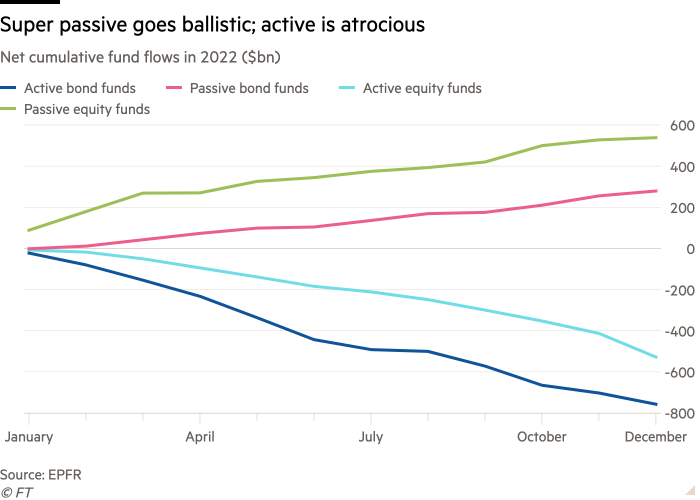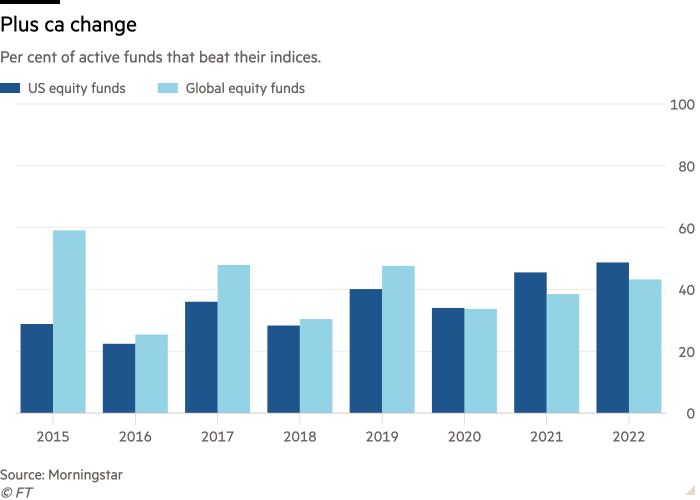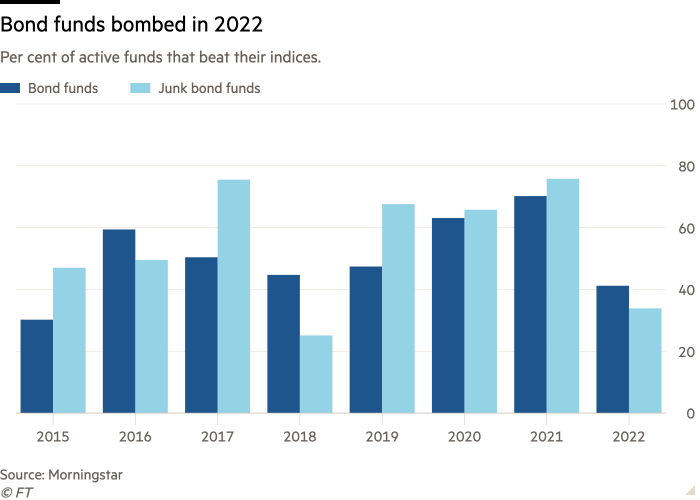Super passive goes ballistic; active is atrocious

Roula Khalaf, Editor of the FT, selects her favourite stories in this weekly newsletter.
With apologies to Mary Poppins, the Scottish Sun sub-editor Paul Hickson, and all the people who suggested the above headline would be the best title to a book on index funds.
Here is the final result of the asset management’s fund flow contest in 2022, from EPFR data.

Obviously most investors will claim that they are in the asset management game, not the asset gathering game. So what was their investment performance like?
The full annual round-ups from the likes of S&P Dow Jones Indices and Morningstar won’t be out for a while, but FT Alphaville got some of the preliminary data from Morningstar. They will do nothing to change the fund flow trajectory of recent years.
Last year WAS somewhat less bad than usual. Global equity funds (World large-blend in Morningstar’s category system) had their best year since 2015, and US stockpickers (US large blend) their best in a decade.
But as you can see, a majority of both categories still underperformed their benchmarks after costs. Only 48.7 per cent of US equity funds beat their indices, and only 43.2 per cent of global ones.

Fixed income funds tend to do a bit better, thanks to the inefficiency of bond markets and flaws in bond index construction. But it was a similar story there in 2022, despite plenty of volatility that should (at least in theory) have made for a rich environment for active managers.
Only 41.2 per cent of classic bond funds (“intermediate core” in Morningstar’s system) surpassed their benchmarks, and measly 33.8 per cent of high-yield bond funds.

That the latter did so particularly badly after a three-year period of good results implies that a lot had simply loaded up on far too much risk and paid the price in 2022.
In any given calendar year there will be some portfolio managers that do well, and there might even be years where more than half beat their benchmarks. But they’re rarely the same year after year — the “persistence” of performance is weak.
As a result, the longer-term picture is unremittingly grim for active managers as a group. This is especially true in the ferociously competitive US markets, but remains the case in every asset class.
Over the decade to mid-2022 a mere 12 per cent of US equity funds beat the market. Only about 20 per cent of global equity funds did so. About 40 per cent of bond funds did beat their benchmarks over 10 years, but the weaknesses of fixed income indices are well-known, and the beat rate slumps to 19.8 per cent over 15 years.
For that reason, headlines celebrating “the best year since X” for active managers seem a bit weird.

Sure, by any reasonable understanding of the word, markets aren’t “efficient”. Dumb things happen all the time. The Grossman-Stiglitz Paradox is real. There are investment groups and individual portfolio managers that do seem to have a genuine knack for generating consistently good results over time. And some markets are more rife with active opportunities than others.
The problem is that most of the time that outperformance is gobbled up by fees. And the majority of the even smaller band of investment groups that generate such good results that they more than earn their pay are closed to new investors, or only manage their own wealth.
And things aren’t getting easier just because the passive share of markets keeps going up. Odds are that it’s usually the worse investors that lose out, forcing them to find something else to do and leaving better and better investors on average every year,
That leads to Mike Mauboussin’s “paradox of skill”:
Say I invited you over to my house to play poker on Saturday night — and that you like to win. Your first question should be, “Who else will be there?” If I tell you that there will be some players that are as skilled as you and a couple of rich players who don’t play well, your response should be: “I’ll be right over.” Why? While you know the amount of money entering the house at the beginning of the evening and leaving at the end of the night is the same, you can see how your gain will come at the expense of the weaker players.
On the other hand, if I tell you that the players expected that evening have skill that is equivalent to yours, the response should be: “No thanks, I’m busy.” In this case, there’s no reason to believe that you will come out a winner because there is no mismatch in relative skill. And if you find yourself in a game unsure of which players are weak or strong, learn a lesson from Warren Buffett: “If you’ve been in the game 30 minutes and you don’t know who the patsy is, you’re the patsy.”
In cases where two or more players have the same level of skill — whether that skill is high or low doesn’t matter — the skills of the players offset one another and luck becomes the primary determinant of the outcome. “Players” can be athletes, investors, or business executives. In many competitive realms, including investing, the skills of the participants have improved on an absolute basis but have shrunk on a relative basis. Today’s investor has vastly more resources and training than his or her predecessor from years past. The problem is that investors, broadly speaking, have gotten much better which means that the difference between the skill of the best and the average participant isn’t as great as it used to be.
This was why large parts of Wall Street was so happy with the retail trading boom of 2020-21. More suckers at the table means that they have a greater chance of making money.
However, hope springs eternal, and we’re sure we’re going to see a few articles predicting that THIS will definitely be the year that stockpickers and bond kings thrive.
Forget the past five years. 2023 is, now, the one when active managers will REALLY stage a comeback. No, really.
— Loukia Gyftopoulou (@loukia_g) January 3, 2023
Comments